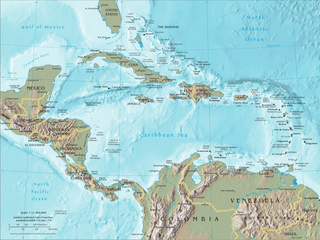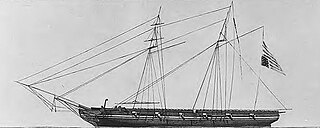Related Research Articles

Edward Teach, better known as Blackbeard, was an English pirate who operated around the West Indies and the eastern coast of Britain's North American colonies. Little is known about his early life, but he may have been a sailor on privateer ships during Queen Anne's War before he settled on the Bahamian island of New Providence, a base for Captain Benjamin Hornigold, whose crew Teach joined around 1716. Hornigold placed him in command of a sloop that he had captured, and the two engaged in numerous acts of piracy. Their numbers were boosted by the addition to their fleet of two more ships, one of which was commanded by Stede Bonnet; but Hornigold retired from piracy toward the end of 1717, taking two vessels with him.

A privateer is a private person or ship that engages in maritime warfare under a commission of war. Since robbery under arms was a common aspect of seaborne trade, until the early 19th century all merchant ships carried arms. A sovereign or delegated authority issued commissions, also referred to as a letter of marque, during wartime. The commission empowered the holder to carry on all forms of hostility permissible at sea by the usages of war. This included attacking foreign vessels and taking them as prizes, and taking prize crews as prisoners for exchange. Captured ships were subject to condemnation and sale under prize law, with the proceeds divided by percentage between the privateer's sponsors, shipowners, captains and crew. A percentage share usually went to the issuer of the commission.

The era of piracy in the Caribbean began in the 1500s and phased out in the 1830s after the navies of the nations of Western Europe and North America with colonies in the Caribbean began combating pirates. The period during which pirates were most successful was from the 1660s to 1730s. Piracy flourished in the Caribbean because of the existence of pirate seaports such as Port Royal in Jamaica, Tortuga in Haiti, and Nassau in the Bahamas. Piracy in the Caribbean was part of a larger historical phenomenon of piracy, as it existed close to major trade and exploration routes in almost all the five oceans.

The Bermuda sloop is a historical type of fore-and-aft rigged single-masted sailing vessel developed on the islands of Bermuda in the 17th century. Such vessels originally had gaff rigs with quadrilateral sails, but evolved to use the Bermuda rig with triangular sails. Although the Bermuda sloop is often described as a development of the narrower-beamed Jamaica sloop, which dates from the 1670s, the high, raked masts and triangular sails of the Bermuda rig are rooted in a tradition of Bermudian boat design dating from the earliest decades of the 17th century. It is distinguished from other vessels with the triangular Bermuda rig, which may have multiple masts or may not have evolved in hull form from the traditional designs.
Captain Benjamin Hornigold (1680–1719) was an English pirate who operated during the tail end of the Golden Age of Piracy.

Stede Bonnet was an early 18th-century English/Barbadian pirate, also known as the Gentleman Pirate for the reason that he was a moderately wealthy landowner before turning to a life of crime. Bonnet was born into a wealthy English family on the island of Barbados, and inherited the family estate after his father's death in 1694. Despite his lack of sailing experience, Bonnet decided he should turn to piracy in the winter of 1716 or spring of 1717. He bought a sailing vessel, the Revenge, and travelled with his paid crew along the Eastern Seaboard of what is now the United States, capturing other vessels and burning other Barbadian ships.

Benito de Soto Aboal Pontevedra is in Galicia in northern Spain where the language is close to Portuguese, which has confused some sources that say he was Portuguese. He was captain of the pirate ship Defensor de Pedro, sometimes incorrectly named as the Burla Negra, that was responsible for several piracies in the Atlantic in 1828, in a period of increased piracy following the independence of the new states of South America. The most notable attacks were on the British Indiaman Morning Star and the American ship Topaz, which involved great violence. De Soto was captured and tried in Gibraltar on 20 January 1830 and he was hanged on 25 January. Other members of his crew were captured in Spain. Their trial there began on 19 November 1829 and ten men were executed on 11 and 12 January 1830.
Henry Jennings was an 18th-century English privateer from the colony of Bermuda, who served primarily during the War of the Spanish Succession and later served as leader of the pirate haven or "republic" of New Providence.
The Antelope, 23 U.S. 66 (1825), was a case in which the Supreme Court of the United States considered, for the first time, the legitimacy of the international slave trade, and determined "that possession on board of a vessel was evidence of property".

The Capture of Veloz Passagera was a single-ship action that occurred during the British Royal Navy's anti-slavery blockade of Africa in the early and mid 19th century. The sloop-of-war HMS Primrose, of 18 guns, under Captain William Broughton, captured the 20-gun Spanish slave ship Veloz Passagera, Jozé Antonio de la Vega, master.

The West Indies Anti-Piracy Operations refer to the United States Navy presence in the Antilles, and surrounding waters, which fought against pirates. Between 1817 and 1825, the American West Indies Squadron constantly pursued pirates on sea and land, primarily around Cuba and Puerto Rico. After the capture of Roberto Cofresi in 1825, acts of piracy became rare, and the operation was considered a success, although limited occurrences went on until slightly after the start of the 20th century.

Piracy was a phenomenon that was not limited to the Caribbean region. Golden Age pirates roamed off the coast of North America, Africa and the Caribbean.
José Joaquim Almeida, was a Portuguese-born American privateer who fought in the Anglo-American War of 1812 and the Argentine War of Independence.
Thomas Mostyn was a sea captain and slave trader active between New York and the Indian Ocean, and later in the Caribbean. He was one of the traders employed by New York merchant Frederick Philipse to smuggle supplies to the pirates of Madagascar.

The Flying Gang was an 18th-century group of pirates who established themselves in Nassau, New Providence in the Bahamas after the destruction of Port Royal in Jamaica. The gang consisted of the most notorious and cunning pirates of the time, and they terrorized and pillaged the Caribbean until the Royal Navy and infighting brought them to justice. They achieved great fame and wealth by raiding salvagers attempting to recover gold from the sunken Spanish treasure fleet. They established their own codes and governed themselves independent from any of the colonial powers of the time. Nassau was deemed the Republic of Pirates as it attracted many former privateers looking for work to its shores. The Governor of Bermuda stated that there were over 1,000 pirates in Nassau at that time and that they outnumbered the mere hundred inhabitants in the town.
James Allison was a pirate and former logwood hauler, active near Cape Verde and the Bay of Campeche. Almost the entire record of Allison's piracy comes from trial records of a single incident, the seizure of the merchantman Good Hope.
Simon Mascarino was a Portuguese pirate active in the Caribbean. He was also a privateer in service of the Spanish.
Thomas Larimore was a privateer and pirate active in the Caribbean and off the eastern seaboard of the American colonies. After helping suppress Bacon’s Rebellion and serving as a militia leader he turned to piracy, his activities intertwined with those of fellow pirate John Quelch.
Paulsgrave Williams, first name occasionally Paul, Palsgrave, or Palgrave, was a pirate who was active 1716–1723 and sailed in the Caribbean, American eastern seaboard, and off West Africa. He is best known for sailing alongside Samuel Bellamy.
References
- ↑ John Franklin Jameson, ed., Privateering and Piracy in the Colonial Period (2008), 392–393, digital file
- ↑ Jameson, Privateering and Piracy, 384.
- ↑ Jameson, Privateering and Piracy, 392.
- ↑ Jameson, Privateering and Piracy, 399.
- ↑ Jameson, Privateering and Piracy, 399.
- ↑ Jane Landers, Black Society in Spanish Florida (Urbana: University of Illinois Press, 1999), 42.
- ↑ Jameson, Privateering and Piracy, 384, 395, 410–411, 414, 416.
- ↑ Landers, Black Society, 301.
- ↑ Jameson, Privateering and Piracy, 408.
- ↑ Jameson, Privateering and Piracy, 425–430.
- ↑ Jameson, Privateering and Piracy, 431–434.
- ↑ Jameson, Privateering and Piracy, 434–442.
- ↑ Jameson, Privateering and Piracy, 442–462